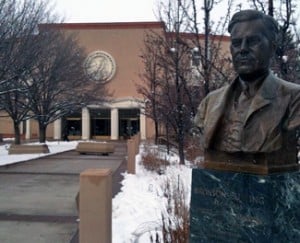
The Roundhouse in Santa Fe (Photo by Peter St. Cyr)
In recent years New Mexico has frequently been cited as a model state for reforming drunk driving laws and policies. Particular attention has been paid to a 2005 law requiring ignition interlock devices for all convicted drunk drivers.
That attention is not deserved. While New Mexico does indeed seem to be enjoying a mostly downward trend in alcohol-impaired fatalities over the last several years, that trend is not the result of any discernable effect of the interlock law.
The problem is that policymakers have largely accepted without challenge a body of oft-cited research on interlock effectiveness coupled with exaggeration of that research by interlock advocates. For example, Mothers Against Drunk Driving (MADD) has gone so far as to claim that interlocks are entirely responsible for a 35 percent reduction in alcohol-impaired fatalities in New Mexico from 2005 to 2008.
But association is not necessarily causation. In fact, it should be noted that even as interlock use accelerated in 2009 there was an uptick in alcohol-impaired fatalities.
Interlock law had little or no discernable effect
The oft-cited research has been led by Richard Roth of Impact DWI in Santa Fe. He and his research team claim that the interlock law has substantially reduced long-term repeat offenses (recidivism) by up to 18 percent. But in a study I authored (released recently by the Rio Grande Foundation) I found numerous, textbook statistical errors in their empirical work.
There can be no confidence in the Roth team’s claim. It is clear even from their research, however, that interlocks have no lasting, long-term effect on driver behavior. The researchers themselves questioned the long-term effectiveness of interlocks in comparing offenders who had had interlocks to those who did not. They write that, “after the interlock was removed, there was no significant difference in the recidivism rates” between the two groups.
Regarding the interlock law’s effect on fatalities, I found New Mexico’s interlock law had little or no discernable effect in reducing fatalities. Based on arrest and fatality data from 2008, my study calculated a plausible range of likelihoods of an innocent person being killed by the typical drunk driver. Those data suggest, even using the Roth team’s problematic estimate of interlock’s deterrent, that the interlock policy would save less than one innocent victim per year on average.
That the interlock mandate directly costs some $13.1 million per year suggests that it is not cost effective.
Refocus on the most dangerous
In an interview, New Mexico’s recent DWI czar, Rachel O’Connor, generally agreed with my assessment. That drunk driving fatalities in New Mexico generally decreased from 2005 to 2009 may be partially due to a statewide emphasis on policy modifications (including interlocks), media campaigns and high-visibility enforcement. Of course, more responsible attitudes about driving drunk nationwide or just plain luck may also have contributed to the decrease.
My research focuses on the likelihood that the “typical” drunk driver kills an innocent victim. While that may sufficient to challenge exaggerated, big-picture assertions by the Roth team and interlock advocates, it leaves open the question of how interlocks might be used in a cost-effective manner.
The answer, it seems to me, is to refocus attention from the “typical” drunk driver to the most dangerous drunk drivers. Not all drivers who have consumed alcohol are equally dangerous. What are the attributes of those we would consider to be most dangerous, i.e. those with the higher likelihoods of killing an innocent victim?
I urge Roth and his team to shift emphasis to that question in future research. Requiring that interlocks be installed for long periods of time may be a cost-effective way to deter the most dangerous drivers and thereby save innocent lives.
Peer review and debate needed
In any event, policymakers should view the claims of advocates with a good deal more skepticism. Only peer review and healthy academic debate will help improve our understanding of effectiveness of DWI policies in New Mexico. In that vein, I recommend that the rich but closely held dataset that has been provided to the Roth team be accessible to other researchers.
That could be accomplished by moving some funding from the DWI czar’s budget to UNM for maintenance and serving of the dataset, making it is accessible to interlock advocates and skeptics alike.
Policymakers seeking to replicate New Mexico’s interlock law should pause. Much less is known about interlocks’ effectiveness than previous research would have us believe. Interlocks are not a panacea. The devices may be most effective if we can figure out how to target them at the most dangerous offenders and leave them on those offenders’ cars for longer periods of time.
Harry Messenheimer is the co-founder of and a senior fellow with New Mexico’s Rio Grande Foundation, an independent, non-partisan, tax-exempt research and educational organization dedicated to promoting prosperity for New Mexico based on principles of limited government, economic freedom and individual responsibility.